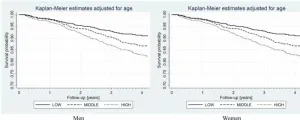(Press-News.org) (Boston)—Cannabis is one of the most widely used drugs, with an estimated 219 million users globally in 2021, with the highest number of users in the Americas. It is also the most used drug among young people. In the U.S., cannabis use among young adults (age 19 to 22) reached a historically high level in 2021, with 42.6% reporting use in the past year.
Effects and impact of recreational cannabis legalization and decriminalization on societies is a topic of global relevance and increasing scientific interest. Despite a rapidly growing body of published evidence, findings remain mostly mixed with little attention given to young adults.
A new study from researchers at Boston University Chobanian & Avedisian School of Medicine and Boston Medical Center (BMC) has found that cannabis use among young adults in the country of Georgia, did not increase following recreational use legalization, despite having easier access.
“We saw that a country can carefully legalize cannabis use, without a surge in use in the mid-term. It would be reasonable to additionally actively regulate and control production and distribution, to restrict black market, control the quality of products while keeping populations, particularly young people, safe. We need more studies, preferably longitudinal, from different populations and socio-political contexts, to inform societies and policy makers how to balance between liberty and health.” said corresponding author Ilia Nadareishvili, MD, PhD, a National Institute on Drug Abuse (NIDA) International Visiting Scientists and Technical Exchange Program (INVEST) fellow working in general internal medicine at the school and BMC.
Georgia legalized cannabis consumption and decriminalized cannabis possession in 2018, becoming one of the first countries in the world and the first in the region to do so. Restrictions on use by persons younger than 21, including the sale and distribution, were retained. The researchers conducted a national, wide-scale survey in 2015 and again in 2022, comparing the data to see how cannabis use changed among young adults following legalization. While usage did not increase following the legalization, they did find age of first use increased significantly. Additionally they found the use of cannabis was associated with gambling, tobacco smoking, alcohol use and with having a higher income.
According to the researchers, recreational cannabis use legalization, as implemented in Georgia, could be a useful example of balancing public liberty and public health interests. “This research provides crucial scientific evidence to inform the ongoing discussions surrounding the impact of cannabis legalization, particularly its limited effect on usage rates among emerging adults. The findings offer a critical contribution to both local and international discourse on drug policy and public health.” added Irma Kirtadze, MD, PhD, from Ilia State University (Georgia).
Mentored by BU/BMC’s Karsten Lunze MD, MPH, DrPH and Jeffrey Samet, MD, MA, MPH, Nadareishvili is the sixth NIDA INVEST fellow to join the BU/BMC team. Other researchers involved in this study include: Sowmya R Rao, MA, PhD from BU School of Public Health; Natalia Gnatienko from BMC, and David Otiashvili, MD, PhD from Ilia State University (Georgia).
These findings appear online in the journal Addiction.
Funding for this study was provided through the National Institutes of Health, National Institute on Drug Abuse, 2023 and 2024 NIDA INVEST Drug Use and Addiction Research Fellowship
END
The Autism Transitions Research Project, funded by the Health Resources and Services Administration and led by Drexel University’s A.J. Drexel Autism Institute, has released new findings that underscore critical challenges and opportunities in transitioning autistic youth into adulthood. As approximately 1.2 million autistic individuals are expected to reach adulthood in the coming decade, these insights are vital for shaping future research and services.
The study, “Challenges and Opportunities in Transitioning Autistic Individuals into Adulthood,” led by Anne M. Roux, a research scientist and director at the Policy Impact Project in the ...
Quantum defects have the potential to act as ultra-sensitive sensors that could offer new kinds of navigation or biological sensor technology.
One type of these defect systems, nitrogen vacancy (NV) centers in diamonds, can measure nanoscale magnetic fields. But while scientists can control the quantum spin of these centers — single defects in the diamond, where nitrogen has replaced the carbon — they still do not have a full understanding of how to best isolate that spin from the spins of other defects in the material, which can destroy its quantum state memory, ...
Glioblastoma is the most common – and the most malignant – primary brain tumour in adults. It’s aggressive and incurable. Even with treatment including surgical removal and chemotherapy, the median survival for patients is just 18 months.
Now, innovative new research led by Dr. Arezu Jahani-Asl, Canada Research Chair in Neurobiology of Disease at the University of Ottawa, provides highly compelling evidence that a drug used to slow the progression of the disease ALS shows promise ...
Demonstrating its commitment to excellence as a member of the Association of American Universities and number one in the state for National Institutes of Health (NIH) funding, the University of Miami has pledged to invest more than $30 million to bolster basic science research that will target neuroscience and aging, some of the most complex conditions confronting the United States population, including in South Florida.
The investment over the next five years will create a new program in ...
When trying to understand how genetic influences factor into youth behavior, researchers at Washington University in St. Louis have taken the “big trawl” approach, casting their net wide to pull in all the measured traits, behaviors and environments that make up who we are and examine associations with the genetic building blocks comprising risk for mental health problems.
This cutting-edge methodology has turned up valuable new insights into factors related to psychopathological genetic risk, ...
“Of note, participants with high serum levels of FGF21 more frequently had metabolic complications, such as hypertension, obesity, diabetes, hypercholesterolemia, and hypertriglyceridemia.”
BUFFALO, NY- October 17, 2024 – A new research paper was published in Aging (listed by MEDLINE/PubMed as "Aging (Albany NY)" and "Aging-US" by Web of Science), Volume 16, Issue 19 on September 18, 2024, entitled, “Fibroblast growth factor 21 inversely correlates with survival in elderly population – the results of the Polsenior2 study.”
As ...
Many plankton journey from the cold, dark depths of our oceans to the surface, only to eventually drift down again into the darkness in a perpetual rhythm. Yet, how single-celled phytoplankton, most of which have no appendages to help them swim, make this pilgrimage has remained a mystery. In a paper publishing October 17 in the Cell Press journal Current Biology, researchers describe a species of bioluminescent phytoplankton, called Pyrocystis noctiluca, that balloons to six times their original size of a few hundred microns. This massive inflation allows the plankton to journey up to 200 meters toward the ocean’s surface to capture sunlight, then ...
Glioblastomas are aggressive brain tumors with a median survival time of less than 22 months despite standard therapy including surgery, irradiation, and chemotherapy. It has become clear in recent years that not all cells within the brain tumor have an equal potential to divide and drive tumor growth. As such, a fraction of tumor cells called brain tumor stem cells (BTSCs) are thought to be the primary origin of tumor re-growth after surgery in addition to being resistant to standard treatments including chemotherapy and irradiation. Therefore, targeting BTSCs may be a way to effectively treat glioblastomas.
In an effort to rapidly identify ...
It may soon be possible to determine which patients with a type of liver cancer called hepatocellular carcinoma would benefit from immunotherapy, according to a preclinical study by Weill Cornell Medicine investigators.
The study, published Oct. 17 in Molecular Cell, provides new insights into a pair of proteins, called p62 and NBR1, and their opposing functions in regulating the interferon response in hepatic stellate cells, a critical immune component in the liver’s fight against tumors. The study demonstrates that high levels of the immune-suppressing NBR1 in these specialized cells may identify patients who are unlikely to respond ...
About The Study: This meta-analysis found that an estimated 2.56% of people 40 years or older have glaucoma, slightly more than estimated by previous studies. Black individuals are disproportionately affected. Prevalence estimates at the state and county level can help guide public health planning.
Corresponding Author: To contact the corresponding author, Joshua R. Ehrlich, MD, MPH, email joshre@umich.edu.
To access the embargoed study: Visit our For The Media website at this link https://media.jamanetwork.com/
(doi:10.1001/jamaophthalmol.2024.3884)
Editor’s ...




